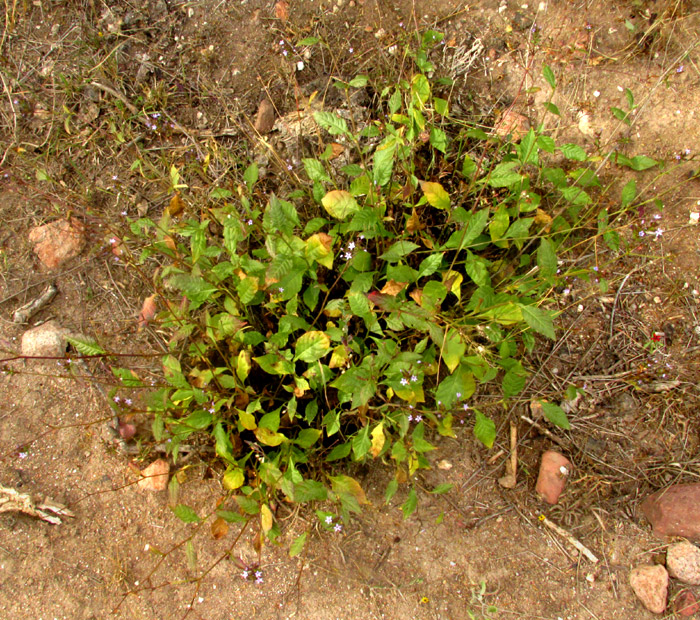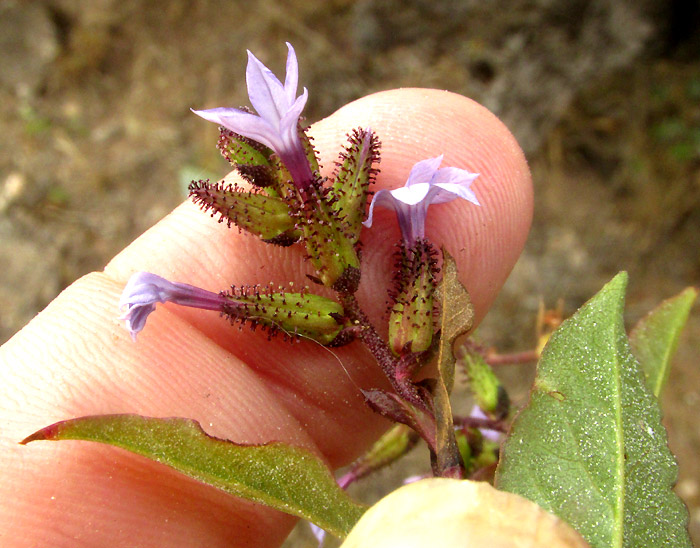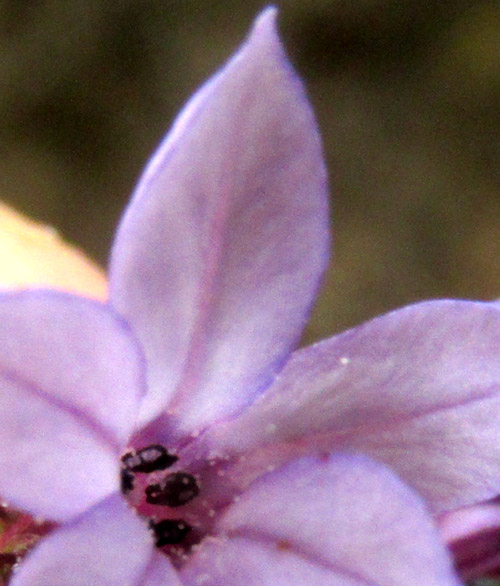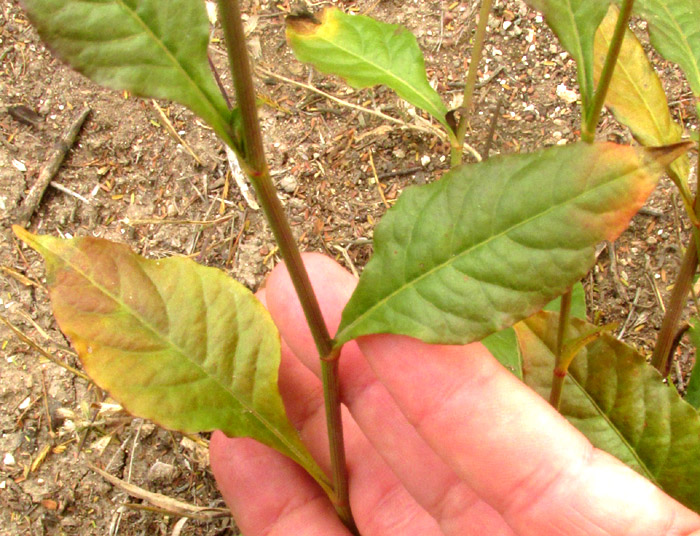Excerpts from Jim Conrad's
Naturalist Newsletter
Entry dated December 2, 2023, issued from near Tequisquiapan; elevation about 1,900m, (6200 ft), ~N20.57°, ~W99.89°; Querétaro state, MÉXICO
COLA DE IGUANA

During the ongoing two-year dry period classified by the North American Drought Monitor as an extreme D3 drought, and after the rainy season failed to develop this year, much of the landscape is brown and crispy dry. On an hour-long hike through the scrub, the only flowering plants encountered were a few Sweet Acacias. Only, that is, except for the above plant, a bit wilted and yellowing, but flowering along a trail through a grossly overgrazed, eroded, thin-soiled abandoned area. Its small, pale blue flowers clustered around the compact herbage like sparks from a campfire.

The flowers consisted of pale purplish-blue corollas with five lobes abruptly spreading from atop corolla tubes. The tubes emerged from large calyxes bristling with conspicuous hairlike projections tipped with sticky glands. That's exactly the combination of features characterizing the leadworts, genus Plumbago, of the Leadwort Family, the Plumbaginaceae. Leadwort species commonly occur in the tropics and subtropics worldwide. Our scrub plant can be compared to the Cape Leadwort we've already met.

In the above picture, notice the white spots dotting the leaves' undersides. The spots are composed of calcium-rich salts excreted by "chalk glands," sometimes called salt glands, appearing on many Plumbago species. A good guess is that the glands help the plant deal with the drought, though I find no studies proving this. At the right, the black anthers of five stamens -- 5 sepals, 5 corolla lobes and 5 stamens being required in this family -- are visible at the corolla's throat.

In this group, though, the prominent feature is the stalked glands. Over the years there's been much discussion about why they exist. They certainly keep crawling invertebrates from climbing the stems and eating flowers, but much less sturdy glandular hairs accomplish the same on many unrelated species. The glands may somehow help with drought and salt tolerance, but many species adapted to limited water and salty soil don't have them. I think the local house cat supplies the main answer: He spends his days beneath a big Plumbago shrub in the backyard, and when he comes out his fur is thick with adhering Plumbago fruits. The fruits are enveloped by sticky calyxes; the stalked glands provide seed dispersal.

Blade bases of the simple leaves gradually narrowed to the petioles' bases.
About 25 Plumbago species currently are recognized worldwide, but not showing up in the cooler parts of North America and Eurasia. The Flora del Bajío, which documents plants for our part of upland central Mexico, reports two Plumbago species for our area: one with white flowers and the other, ours, with purplish blue ones. Our scrub plant is PLUMBAGO PULCHELLA, known by no English name, though often among English speakers the Spanish name is used, which is cola de iguana, or "iguana tail." The pulchella in the binomial is a Latin adjective describing anything small and beautiful.
Plumbago pulchella is endemic to most of Mexico's uplands. Despite only occurring in Mexico, the species is regarded as common in many habitats, ranging from our semiarid scrub to pastures and various forest types, and often in disturbed situations. Our plant out in the scrub proves that one of the species' prime adaptations is its drought tolerance.
The fact that our plant was flourishing in an area where every grassblade and herb had been nibbled down to a stump causes the suspicion that the species may bear toxic compounds. In fact, in the 2017 study by Angel Josabad Alonso-Castro and others entitled "Medicinal Plants from North and Central America and the Caribbean Considered Toxic for Humans: The Other Side of the Coin," Plumbago pulchella is listed as "considered as toxic." However, in the 2023 study by Fernanda I. Calzada-González and others entitled "Plumbagin Extraction: A Green Study," it's stated that "... according to a profound literature search, no chemical information for Plumbago pulchella Boiss is accessible."
Still, the study by Angel Josabad Alonso-Castro and others also reports that the species has been used in Mexican traditional medicine to treat diabetes, skin burns and vomiting, as well as to encourage wounds to heal. The online "Atlas de las Plantas de la Medicina Tradicional Mexicana" expands on that list, and reports that in the 1500s Francisco Hernández -- presumably the conquistador Franciso Hernández in the Yucatan peninsula -- wrote that indigenous people there used the herb against tooth decay, syphilis, belly pain caused by the cold, chest problems and flatulence, plus its use encouraged urination, alleviated colic, and cured gangrene. And if the plant's juice was mixed with a plant called etemecatl, it favored conception.
Despite plenty of literature describing such uses in traditional medicine, several studies also mention that juice of Plumbago pulchella is known to stain the skin and cause irritation and blisters, but I find no clinical studies confirming that.